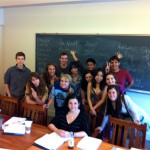Belonging Response
Forums › 2023 Summer Seminar › Belonging 2023 Summer Seminar Responses: due JUNE 8 (or earlier) › Belonging Response
-
AuthorPosts
-
-
June 14, 2023 at 2:33 pm #31840
I enjoyed the complexity and the multitude of perspectives of Krug’s graphic narrative (hers, her aunt’s, her mom’s, her dad’s and the townsfolk). It’s ironic to think that when graphic narratives came into the forefront of literary circles that many “experts” cast them off as unworthy literature. Art Spiegelman’s Maus broke that barrier and opened the door for a legitimate medium suited for traumatic memory and experiences that allow the writer to work through the trauma. The word/image combination lends itself to the combination of past/present and oral history/testimony. The graphic medium also encourages the readers to become active participants and witnesses to the author’s story. As a reader and witness, I found an urgency as I turned the pages to find out what Krug would uncover with each encounter and discovery. Was her family guilty or innocent of what she believed to be their history? The photos from the war humanized all of the people from her town
As I have used Miriam Katin’s graphic narrative, We Are on Our Own in my Holocaust course, the graphic medium struck my students in a myriad of ways that could not have happened with a standard narrative format. The use of color, lack of color, drawn and photographic images, notations, etc. are the bits and pieces of a person’s story that pulls readers into the narrative. When I interviewed Ms.Katin, she said it was a simple true story of hiding in plain sight and a way for her to become unstuck from her past. I found Krug’s graphic narrative to be a medium for her to become unstuck from her weighty German family history.
It is fascinating to me that when Krug came to NYC, one of her first encounters meeting people was with a Holocaust survivor. The wheels began turning in her head as the survivor shared her story. Her German guilt surfaced, but she did not have any semblance of her family’s guilt or hometown’s history. She has to go back “follow the bread crumbs, and hope they’ll lead the way home”. As she searches and searches and finds out about her family, the Germans, and the Jews of her hometown. It all seems to resonate back to her uncle’s death. His death affects the entire trajectory of the family and their fractured relationships with one another.
In the end, I believe she does uncover some semblance of her “Heimat” as she raises her glass of wine with her relatives in her hometown. She is “comfortable” in knowing the truths she unveiled through her research. Will there be unanswered questions? Always. I feel this is not unique to anyone’s family history. People pass. We forget to ask the questions that may give answers that plug the holes of our uncertainty. But, it doesn’t mean that the “home” you have discovered along the way is not real or worthy. Krug proves that with her beautiful graphic narrative.
-
-
AuthorPosts
- You must be logged in to reply to this topic.
Recent Replies
Recently Active
-
Active 1 day, 9 hours ago
-
Active 2 days, 9 hours ago
-
Active 2 days, 13 hours ago
-
Active 3 days, 6 hours ago
-
Active 1 week, 1 day ago
- View All Members






